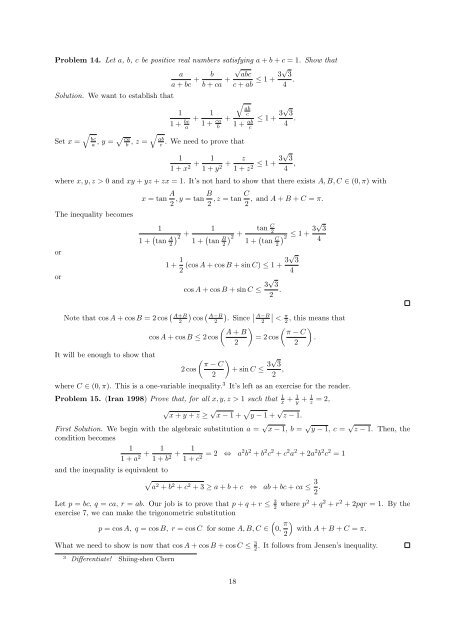Topics in Inequalities - Theorems and Techniques Hojoo ... - Index of
Topics in Inequalities - Theorems and Techniques Hojoo ... - Index of
Topics in Inequalities - Theorems and Techniques Hojoo ... - Index of
You also want an ePaper? Increase the reach of your titles
YUMPU automatically turns print PDFs into web optimized ePapers that Google loves.
Problem 14. Let a, b, c be positive real numbers satisfy<strong>in</strong>g a + b + c = 1. Show that<br />
Solution. We want to establish that<br />
Set x =<br />
√<br />
bc<br />
a , y = √ ca<br />
b , z = √<br />
a<br />
a + bc + b<br />
√<br />
abc<br />
b + ca + c + ab ≤ 1 + 3√ 3<br />
4 .<br />
1<br />
1 + bc a<br />
+ 1<br />
1 + ca b<br />
+<br />
√<br />
ab<br />
c<br />
1 + ab<br />
c<br />
ab<br />
c<br />
. We need to prove that<br />
≤ 1 + 3√ 3<br />
4 .<br />
1<br />
1 + x 2 + 1<br />
1 + y 2 + z<br />
1 + z 2 ≤ 1 + 3√ 3<br />
4 ,<br />
where x, y, z > 0 <strong>and</strong> xy + yz + zx = 1. It’s not hard to show that there exists A, B, C ∈ (0, π) with<br />
The <strong>in</strong>equality becomes<br />
x = tan A 2 , y = tan B 2 , z = tan C , <strong>and</strong> A + B + C = π.<br />
2<br />
or<br />
or<br />
1<br />
1 + ( 1<br />
)<br />
tan A 2<br />
+<br />
2<br />
1 + ( tan C 2<br />
)<br />
tan B 2<br />
+<br />
2<br />
1 + ( tan C 2<br />
1 + 1 2 (cos A + cos B + s<strong>in</strong> C) ≤ 1 + 3√ 3<br />
4<br />
cos A + cos B + s<strong>in</strong> C ≤ 3√ 3<br />
2 .<br />
) 2<br />
≤ 1 + 3√ 3<br />
4<br />
Note that cos A + cos B = 2 cos ( ) (<br />
A+B<br />
2 cos A−B<br />
) ∣ 2 . S<strong>in</strong>ce A−B ∣<br />
2<br />
< π 2<br />
, this means that<br />
( ) ( )<br />
A + B<br />
π − C<br />
cos A + cos B ≤ 2 cos = 2 cos .<br />
2<br />
2<br />
It will be enough to show that<br />
( ) π − C<br />
2 cos + s<strong>in</strong> C ≤ 3√ 3<br />
2<br />
2 ,<br />
where C ∈ (0, π). This is a one-variable <strong>in</strong>equality. 3 It’s left as an exercise for the reader.<br />
Problem 15. (Iran 1998) Prove that, for all x, y, z > 1 such that 1 x + 1 y + 1 z = 2,<br />
√ x + y + z ≥<br />
√<br />
x − 1 +<br />
√<br />
y − 1 +<br />
√<br />
z − 1.<br />
First Solution. We beg<strong>in</strong> with the algebraic substitution a = √ x − 1, b = √ y − 1, c = √ z − 1. Then, the<br />
condition becomes<br />
1<br />
1 + a 2 + 1<br />
1 + b 2 + 1<br />
1 + c 2 = 2 ⇔ a2 b 2 + b 2 c 2 + c 2 a 2 + 2a 2 b 2 c 2 = 1<br />
<strong>and</strong> the <strong>in</strong>equality is equivalent to<br />
√<br />
a2 + b 2 + c 2 + 3 ≥ a + b + c ⇔ ab + bc + ca ≤ 3 2 .<br />
Let p = bc, q = ca, r = ab. Our job is to prove that p + q + r ≤ 3 2 where p2 + q 2 + r 2 + 2pqr = 1. By the<br />
exercise 7, we can make the trigonometric substitution<br />
(<br />
p = cos A, q = cos B, r = cos C for some A, B, C ∈ 0, π )<br />
with A + B + C = π.<br />
2<br />
What we need to show is now that cos A + cos B + cos C ≤ 3 2<br />
. It follows from Jensen’s <strong>in</strong>equality.<br />
3<br />
Differentiate! Shi<strong>in</strong>g-shen Chern<br />
18

















